People leave, of course they do. But it’s critical for organizations to retain their best people, and track overall retention to know how well HR programs are performing, and the effect they’re having on the business’s bottom line. Failing to retain good people is costly all round, which is why measuring your employee retention rate should be a business priority.
What is the employee retention rate?
The employee retention rate is a metric that tells you how many employees have chosen to stay at your organization during a set time period. It indicates your organization’s ability to retain a stable workforce, and suggests positive employee experience.
The employee retention rate is different from your other employee retention metrics:
- Employee retention rate measures who stays at your organization
- Employee turnover rate measures who leaves your organization and is replaced
- Employee attrition rate measures who leaves your organization and is not replaced
- Employee churn rate combines the turnover rate and the attrition rate
Calculating your retention rate
You can calculate your employee retention rate with the following formula:
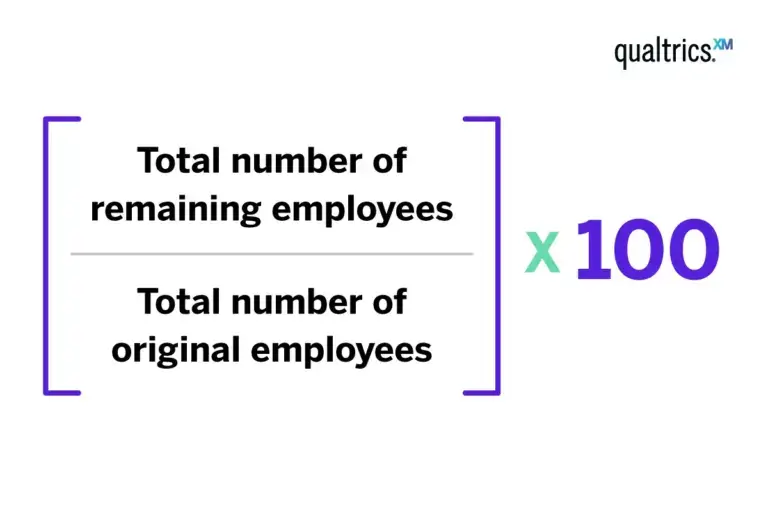
So, say you started the year with 50 employees, and at the end you have 47. Using this employee retention rate formula, you would calculate:
(47/50) x 100 = 94%
You would have a retention rate of 94%. Congratulations – you must be doing something right. You’re keeping most of your employees.
An acceptable employee retention rate varies across industries and organization types, but anecdotally, an average rate of 90% or higher is considered good.
Employee retention rate calculator
Employee Retention Rate Calculator
Your employee retention rate is:
Understanding what drives employee retention rates
The employee retention rate isn’t the oracle when it comes to understanding why your people stay, though. It’s a single metric that counts how many people you have left, rather than painting a broader picture of your employees’ experience.
One organization may be able to boast a high retention rate, but those remaining employees may have nowhere else to go (there may be a recession) and they’re dissatisfied, disengaged, and not performing optimally.
Another organization may have a low retention rate, yet their employees are highly engaged with their work; perhaps the pay and benefits are not enough to keep them in a job they love, or their work-life balance is tilted too much towards work.
You won’t understand why you are losing (or keeping) your employees until you use a more robust and holistic suite of metrics, such as Qualtrics® EX25 that can help you pinpoint what factors make people stay – and go.
EX25 is an experience management (XM) solution, backed by a proven, science-based methodology that takes the guesswork out of what questions to ask employees, when to ask them, and how to act to show them you care about their experiences at work.
Free eBook: Understanding the moments that matter most to your employees
We identified 25 key drivers of every employee’s experience at work, such as work-life balance and collaboration, aligned to the five pillars, or key performance indicators (KPIs), of the employee experience:
- Engagement
- Experience vs Expectations
- Intent to Stay
- Inclusion
- Well-being
By delivering a standard framework to measure the whole employee experience, EX25 gives you confidence to make more informed decisions about what will keep your employees loving their work. When you get the drivers right, your people will be happy, engaged, feel included, have high well-being, and are more likely to stay at your company.
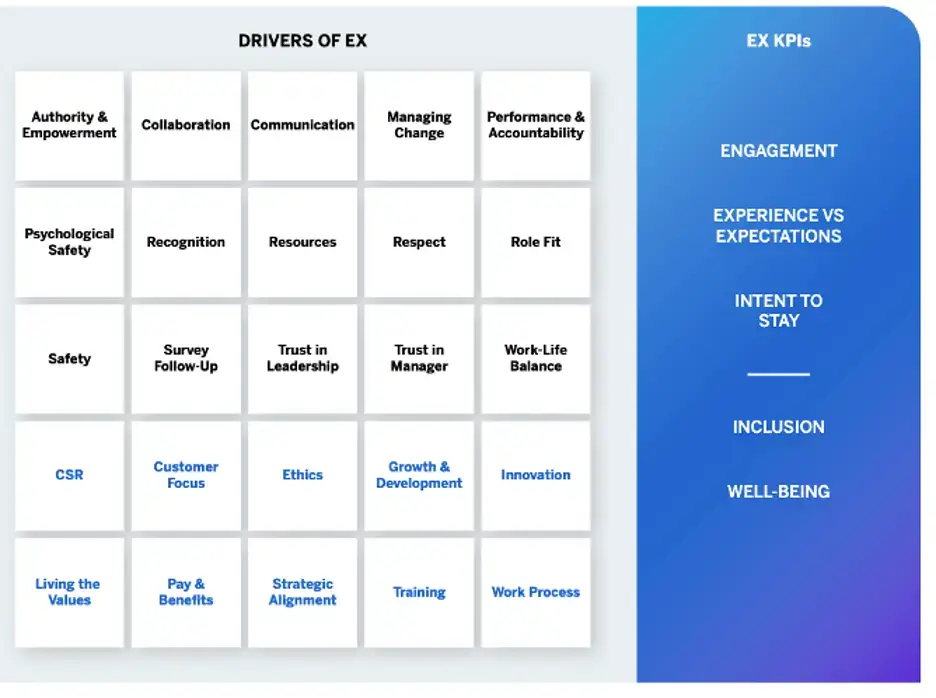
Identifying what really matters to your people
Traditional single metrics such as retention rates and engagement give you only part of the employee experience picture. Are they there? Yes. Are they engaged? Sort of. This isn’t really telling you a whole lot, is it?
You need tools that are far more holistic and analytical:
EX25
When you use methodologies such as EX25 as part of your survey programs, along with continuous listening, you’ll be able to identify blind spots and uncover opportunities to close experience gaps in your workforce.
EX25 will help you go much further to understand the interwoven intricacies of employee experience and spot the gaps that lead to employee churn. Then, you’ll be able make real, data-driven changes to support retention.
EXM exit survey solution
Our EXM exit survey solution helps you understand why your people leave, so you can act across your organization to reduce unwanted attrition. With real-time employee exit insights, you have the data you need to retain top talent and build a happier, more engaged workforce.
Our solution, with its four exit KPIs and six exit drivers, will help you identify the key drivers of attrition and see where to focus your actions, and create real-time alerts for at-risk staff and step in to prevent them leaving.
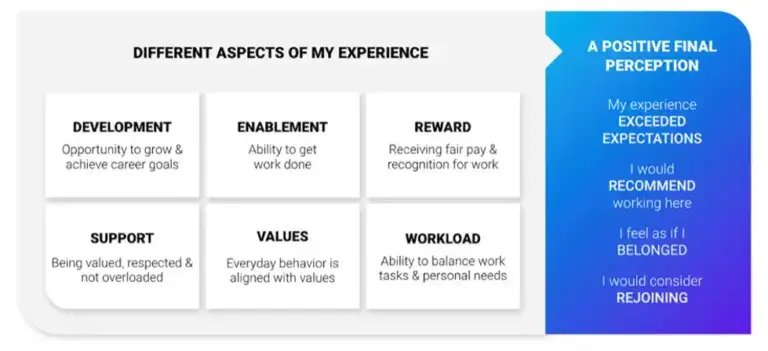
For example, you might find from your surveys or listening programs that employees are unhappy with pay and benefits. Based on exit interview feedback, you find many employees have left as a result of that. From this, you can revise your pay/compensation offers to improve retention.
Ideas for your employee retention strategy
An employee retention strategy is a plan that companies create to reduce employee turnover rates and keep their employees satisfied and engaged. There are many benefits to having an effective employee retention strategy, such as:
- saving costs
- increasing productivity
- enhancing performance
- improving customer satisfaction
- customer retention
- fostering a positive company culture.
So…
1. Hire the right people
Have a great EVP to attract candidates whose values chime with your organization and have a thorough assessment process.
Our 2023 Global Employee Experience Trends report discovered that when employees feel that their organization embodies their values, they’re 27% more likely to have higher engagement scores, and 23% more likely to stay for 3+ years.
You also want to look for people whose skills align with your organizational needs. As we move into the future and the struggle for talent becomes fiercer, organizations need to revise their approach to talent attraction to ensure agility and scalability via skills-based models. These models help organizations to expand their network of candidates and connect the right people to the gaps within their operation.
2. Offer a competitive salary and benefits
Our 2023 report also found that employees who are satisfied with their pay and benefits are 26% more likely to have their expectations exceeded at work, and 13% more likely to continue working with their current employers for 3+ years.
In our 2024 Employee Experience Trends report, we found that 50% of frontline workers are unhappy with their pay and benefits (compared to 64% of non-frontline workers), and 40% of frontline workers are unhappy with their career development (compared to 79% of non-frontline workers).
As those closest to customers, frontline employees have the biggest impact on business outcomes. It’s therefore critical that organizations make the right calls and investments in their frontline people to keep them and empower them.
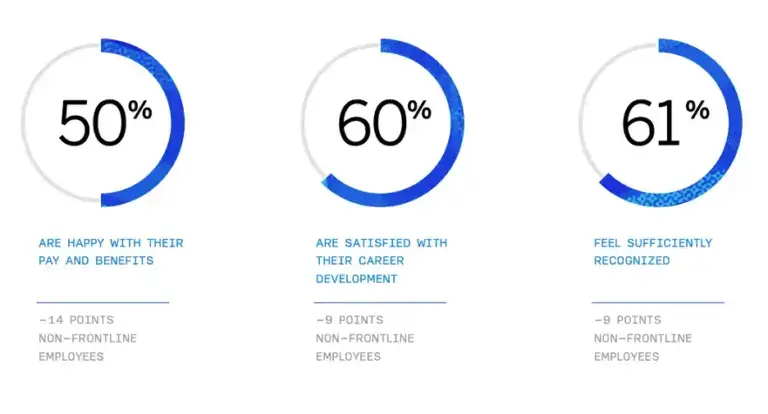
3. Ensure a safe, inclusive workplace
A great company whose culture values respect, collaboration, communication, innovation, and diversity, treasuring all employees, tends to keep them.
But our research found that only 58% of frontline employees feel psychologically safe at work, and 40% say they don’t trust their leadership team, highlighting a worrying issue amongst today’s increasingly disconnected and undervalued workforce.
“Some of the most important drivers of employee experience for frontline workers — such as having the right tools and resources to do the job and feeling psychologically safe — might seem small, but it’s oftentimes the non-obvious aspects that drive customer experience metrics.”
— Dr. Benjamin Granger, PhD, XMP, Head of EX Advisory Services, Chief Workplace Psychologist, Qualtrics
4. Make your managers into leaders
“People don’t leave companies, they leave managers,” so the saying goes.
Managers are core to the employee experience — and bad managers are often a part of why people leave. Therefore, it’s important to understand the overall manager experience, and their overall effectiveness.
For example, what challenges are there for employees? Where can managers help them improve? What do their teams need to thrive? These are simple questions, yes, but often a lack of visibility into the overall experience prevents leaders from taking the right actions to empower managers.
Solutions like Qualtrics Manager Assist, for example, enable managers to build strong, high-performing teams by helping them identify what’s working well, and where and how to take action at scale to ensure teams are engaged, productive and healthy.
With Manager Assist, managers get personalized team engagement results, deep insights based on the drivers of employee experience, and action planning capabilities to ensure they close experience gaps.
5. Plan out employee development
Career development and growth opportunities is the number one reason why people leave organizations.
No employee wants to be ‘stuck’. When you lay out a clear career trajectory for each employee that sets realistic goals, trains and coaches new skills, tracks progress, receives and gives feedback, and celebrates achievements, people will be with you for longer.
6. Be flexible with working arrangements
After working at surge levels for years, employees are now digging their heels in and setting healthy boundaries between work and the rest of their lives. By offering flexible working choices such as remote/home working, hybrid, in-office, job sharing and flexible hours, employers reap rewards.
Our employee experience trends research shows that employees who work from the office 5 days a week have the worst employee experiences overall, whereas those who work 1-3 days at home (or in the office) each week, have the best employee experiences overall across every metric: well-being, inclusion, engagement, experience exceeds expectations, and most crucially on retention — intent to stay
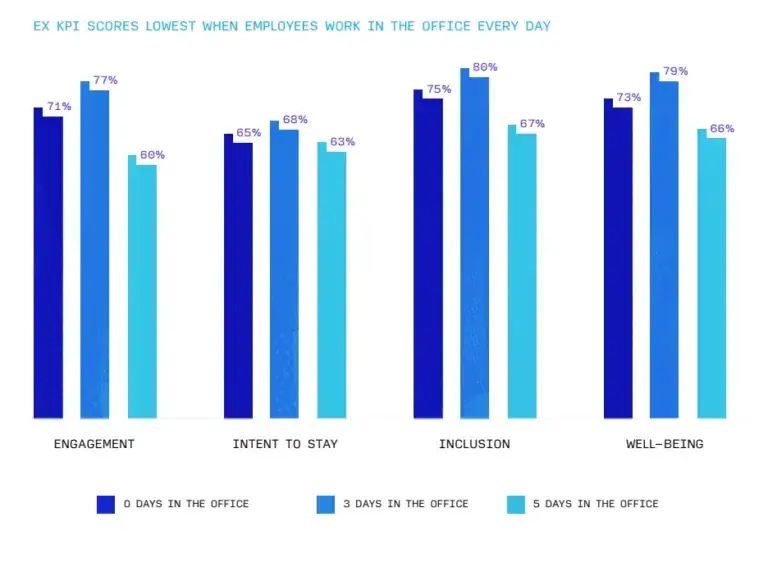
What this ultimately means is that providing working arrangements that best suit the needs of your people leads to improved employee retention, as well as every other experience metric.
Understand what matters most to your people
These strategies are all well and good, and any organization can implement them, but are they really what your people want? Will they help them stay? How will you know?
When you use methodologies like EX25 and our EXM exit survey solution, you’ll be able to understand the employee experience, why people stay or leave, and where to focus without adding complexity to your listening program.
But you can go one step further — with tools such as:
Pulse
Swift, short employee pulse surveys provide more frequent, agile, and actionable employee feedback to uncover timely insights and drive organization impact. Through Pulse, you can get a better read on how your people feel, enabling you to act on the things that might influence employee retention.
360 Development
Personalized to each employee, 360 Development automatically aggregates multi-rater feedback into personalized reports, providing relevant insights to each employee, and supports employees with growth and development (a core reason why people stay or leave organizations).
Continuous employee listening
Listen across every single channel your employees and customers use, so you never miss an opportunity to act and close experience gaps. From social media platforms to the channels where you don’t have a presence, you can tap into what your employees are saying about their experiences so you can work out how to improve them.
Experience benefits optimiser
Automatically turn employee feedback into the perfect benefits package, for you to offer irresistible total reward programs to retain and attract top talent.
Employee journey analytics
Understand how key moments of the employee experience along the employee journey relate to employee engagement, wellbeing, attrition risk, and other key measurements.
Engagement
Get to the heart of what your people care about and build world-class employee experiences with this holistic, easy-to-use platform that includes built-in surveys, workflow, automation and action planning.
Level up your employee experience programs with Qualtrics
Using our tools, you’ll be able to get a complete picture of your entire employee experience, helping you to implement all the right employee retention strategies and keep your great people.
Better yet, why not implement the entire XM for People Teams suite? With XM for People Teams, you have everything you need to build engaged, high-performance teams, improve manager and individual effectiveness, and make timely business decisions that ensure impact and success.
Free eBook: Understanding the moments that matter most to your employees